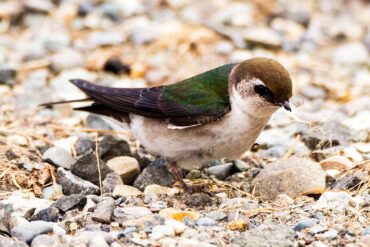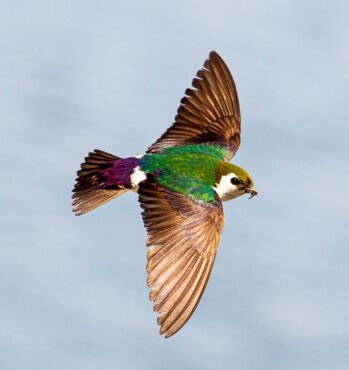
Nothing signals the advent of spring like the arrival of swallows. Among the first migrants to return from a warm winter in the south, swallows are endearing songbirds, many of which live in proximity to humans and nest on man-made structures.
Swallows live virtually anywhere in the world that isn’t covered in ice. Built for flight, they have streamlined bodies with long, pointed wings. To aid their aerial foraging abilities, swallows have a small bill with a wide gape for catching a variety of flying insects, including mosquitoes, flies, moths and wasps. The feathers above their eyes are angled forward to shade them from the sun.
There are 84 recognized species of swallows in the world, eight of which are native to North America. Nearly all of them are widespread, breeding across much of the United States and Canada.
Cave swallows are mainly restricted to Texas and central Mexico and sometimes venture up the Eastern Seaboard. The other seven species can be found in Washington, and all are migratory.
Bank swallows breed in Eastern Washington and sometimes pass through Western Washington in May on their way to Alaska. Six kinds of swallows nest in the West Sound region: purple martin, northern rough-winged, tree, violet-green, barn and cliff swallow.
One species of swallow has a range that is limited to the West. From the Pacific Coast to the Rocky Mountains and from Alaska to Central America, the small, violet-green swallow is a favorite among birders. With its stunning coloration for which it’s appropriately named, the violet-green swallow is a harbinger of spring and a beauty to behold.
Violet-green swallows are often the first swallows to return to West Sound from a warm winter in Mexico or Central America, with some arriving in late February or early March. Migrants that pass through in late fall are likely breeders from farther north.
Violet-green swallows fly higher than most swallows, usually above the treetops. Thus, they’re most often observed from below, where just a white face and belly are visible. But one will occasionally oblige and fly low enough to show its gorgeous upperparts.
Males don a shiny, green cap and back, along with a vivid, violet rump. Females are a more subtle dark green and brown. White on the face and flanks can be diagnostic from a distance, distinguishing the violet-green swallow from its tree swallow cousin. Long wings extend beyond the slightly forked tail when perched.

Although they can be found almost anywhere in Washington, violet-green swallows prefer open woodland habitat and rocky cliffs. They also favor lakes and ponds, where they dart about in search of mosquitoes, sometimes close to the water’s surface, especially in the morning and evening.
Adept in the air, violet-green swallows zip along at speeds up to 28 mph. Spending much of the day in flight, they can also be seen perched in trees and on powerlines while resting. Violet-green swallows are gregarious and tend to forage with other swallows, often in mixed flocks numbering in the hundreds. Sometimes they join with swifts, another aerial forager that spends the entire day on the wing. From a distance, swifts are differentiated from violet-green swallows by more rapid wingbeats.
Violet-green swallows are cavity nesters, often utilizing old woodpecker holes, dead trees, nest boxes, rock crevices or openings on buildings. Preferring to breed in open woodlands near water, violet-green swallows nest alone or in loose colonies of up to 25 pairs.
Nest boxes placed in appropriate habitat are sometimes used. Place them 9-15 feet off the ground. To attract multiple pairs, space boxes at least 30 feet apart.
Both the male and the female gather grass, twigs and feathers for constructing a shallow nest cup in the bottom of a cavity. Clutch size consists of four to six eggs, which the female incubates for two weeks. Nestlings fledge after about 24 days in the nest and both parents continue to care for them until they can fend for themselves. Pairs sometimes raise a second brood.
Violet-green swallow populations are reasonably stable, but the species is highly susceptible to the effects of sudden weather changes during migration, habitat loss, pollution and excessive pesticide use.
Flying insects may be a nuisance to humans, but are essential sustenance for songbirds. Eliminating insects eliminates the birds that rely on them for survival. With the ability to consume hundreds of mosquitoes in a single day, swallows are part of nature’s pest control. Violet-green swallows devour swarms of flying insects every day and look pretty while doing it.
Violet-green swallows are avian neighbors that give you an intimate view of nature. These swooping swallows are graceful to behold. Their iridescent feathers are dazzling in direct sunlight. Watching them offers a peaceful respite from a busy, hectic world.





























